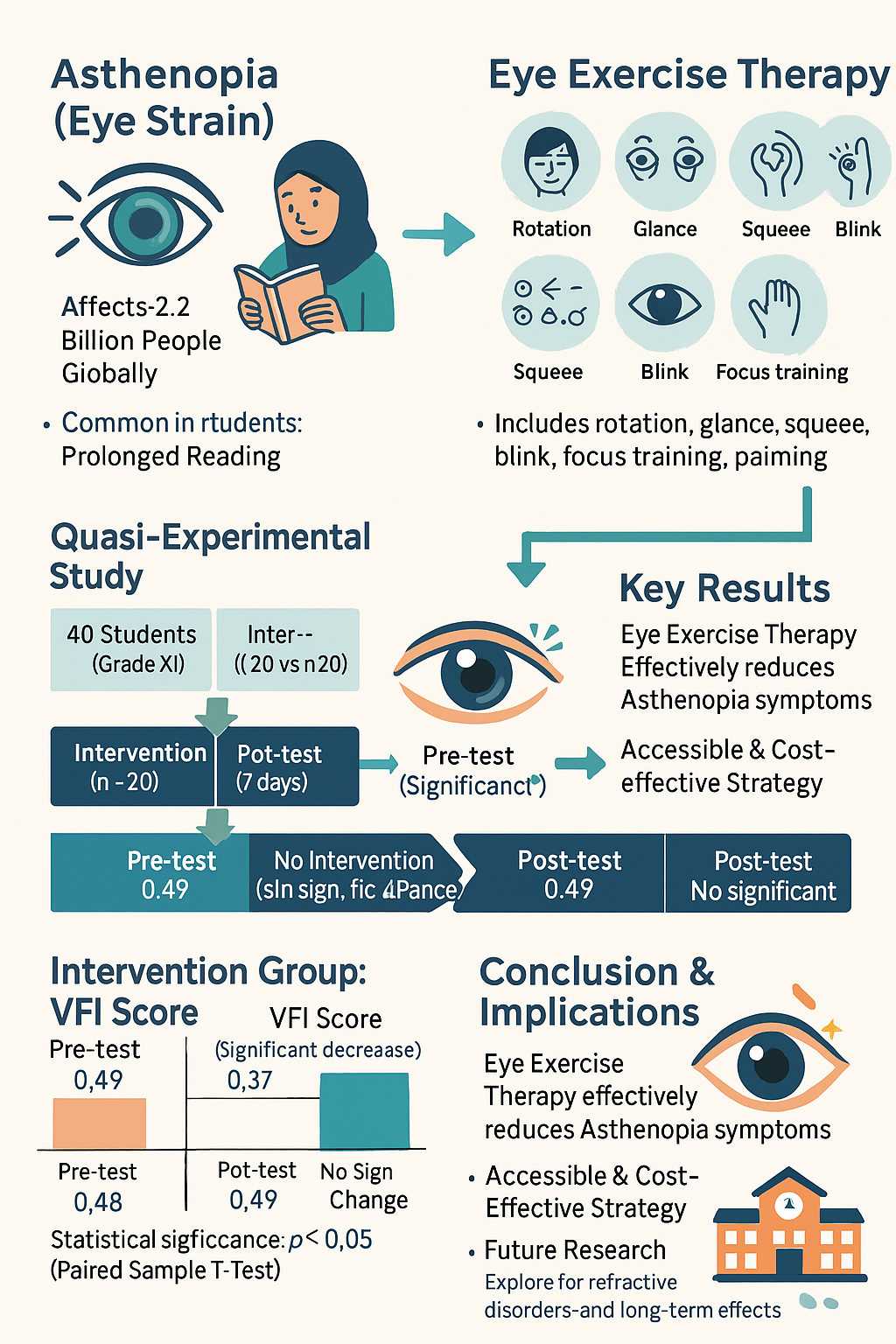Effect of Eye Exercise Therapy on Asthenopia Symptoms Among Islamic Boarding School Students in Cirebon: A Quasi-Experimental Study
https://doi.org/10.33860/bpk.v53i1.4014
Keywords:
asthenopia, eye exercises, VFI ScoreAbstract
Background: There are 2.2 billion people worldwide experiencing eye disorders, with 510 million suffering from untreated vision impairment, and Indonesia is a significant contributor to this issue. Asthenopia is a symptom caused by eye strain, which can lead to vision impairment. This study aims to assess the effect of eye exercise therapy on symptom of asthenopia.
Methods: This research was a quasi-experimental study with a non-equivalent pretest-posttest control group design. The study was conducted at the As-Sunnah Islamic Boarding School in Cirebon, West Java for two months, involving 40 students selected based on inclusion criteria. Subjects were given the Visual Fatigue Index Questionnaire to assess symptoms of asthenopia. Ethical approval was obtained from the Ethics Committee of the Faculty of Pharmacy, YPIB University, No. 111/KEP/EC/IV/2024. Informed consent was provided by the subjects through a 35-item consent form.
Results: Eye exercise therapy has a significant effect on asthenopia symptoms, as evidenced by the Paired Sample T-Test results (p value < 0.05.with the average Visual Fatigue Index (VFI) score decreasing from 0.49 (pre-test) to 0.37 (post-test) in the intervention group, while the control group showed no significant change (0.48 pre-test to 0.49 post-test).
Conclusion: Eye exercise therapy has an effect on Asthenopia symptoms. Future research is recommended to explore the use of eye exercise therapy for refractive eye disorders.
Downloads
References
Abuallut, I., Qumayi, E. A., Mohana, A. J., Almalki, N. M., Ghilan, M. E., Dallak, F. H., Mahzari, S. M., Makrami, A., Tawhari, A., Ajeebi, R. E., & Bakri, S. M. (2022). Prevalence of Asthenopia and Its Relationship with Electronic Screen Usage During the COVID-19 Pandemic in Jazan, Saudi Arabia: A Cross-Sectional Study. Clinical Ophthalmology, 16(September), 3165–3174. https://doi.org/10.2147/OPTH.S377541
ArisandI, I. P. (2018). Efektivitas Senam Mata Terhadap Computer Vision Syndrome (CVS) [Riau university]. https://digilib.unri.ac.id/index.php?p=show_detail&id=74791
Burton, M. J., Ramke, J., Marques, A. P., Bourne, R. R. A., Congdon, N., Jones, I., Ah Tong, B. A. M., Arunga, S., Bachani, D., Bascaran, C., Bastawrous, A., Blanchet, K., Braithwaite, T., Buchan, J. C., Cairns, J., Cama, A., Chagunda, M., Chuluunkhuu, C., Cooper, A., Faal, H. B. (2021). The Lancet Global Health Commission on Global Eye Health: vision beyond 2020. The Lancet Global Health, 9(4), e489–e551. https://doi.org/10.1016/S2214-109X(20)30488-5
Coles-Brennan, C., Sulley, A., Young, G. (2019). Management of digital eye strain. Clin Exp Optom, 102(1), 18–29. https://doi.org/10.1111/cxo.12798. Epub 2018 May 23. PMID: 29797453.
Di Noto, P., Uta, S., & DeSouza, J. F. X. (2013). Eye Exercises Enhance Accuracy and Letter Recognition, but Not Reaction Time, in a Modified Rapid Serial Visual Presentation Task. PLoS ONE, 8(3). https://doi.org/10.1371/journal.pone.0059244
Djing, O. G. (2007). Terapi Mata Dengan Pijat Dan Ramuan. Penebar Swadaya.
Eye health and the Sustainable Development Goals. (n.d.). The International Agency for the Prevention of Blindness. https://www.iapb.org/learn/knowledge-hub/elevate/sustainable-development-goals/eye-health-and-sdgs/
Gupta, S., & Aparna, S. (2019). Effect of yoga ocular exercises on intraocular pressure. Yoga Mimamsa, 51(2), 48. https://doi.org/10.4103/ym.ym_13_19
Harahap, L. A., Hasanah, O., & Elita, V. (2023). Perbedaan Efektifitas Senam Mata dan Akupresur Mata Terhadap Penurunan Gejala Computer Vision Syndrome (CVS) pada Remaja. Health Care: Jurnal Kesehatan, 12(1), 68–77. https://doi.org/10.36763/healthcare.v12i1.293
Ivada, N., Prasetyo, P., Aini, E. N., & Damayanti, D. (2022). Kombinasi Senam Mata Dan Kompres Dingin Terhadap Kelelahan Mata Pada Mahasiswa Stikes Karya Husada Kediri. Seminar Publikasi Ilmiah Kesehatan Nasional (SPIKesNas), 01(01), 270–275.
Laoli, T. lestari. (2022). Hubungan Lama Penggunaan Gadget Terhadap Kejadian Astenopia Pada Mahasiswa Prodi Ners Stikes Santa Elisabeth Medan Tahun 2022. STIKes Santa Elisabeth Medan.
Maisal, F. M., Ruliati, L. P., Berek, N. C., Roga, A. U., & Ratu, J. M. (2020). Efektivitas Senam Mata untuk Mengurangi Tingkat Kelelahan Mata pada Pekerja Rambut Palsu. Jurnal Ergonomi Indonesia (The Indonesian Journal of Ergonomic), 6(1), 9. https://doi.org/10.24843/jei.2020.v06.i01.p02
Martiningsih, W. R., Devi, F., Novitasari, A., & Ratnaningrum, K. (2019). Durasi Membaca Buku merupakan Faktor Risiko Terjadinya Miopia pada Siswa Sekolah Dasar : Studi Perbandingan Rural dan Urban Area Duration of Reading Books Is a Risk Factor for Occurring Myopia in Primary School Students : Rural and Urban Area Comparative. Medica Arteriana, 1(1).
Munif, A., Yuliana, & Wardana, I. N. G. (2020). Hubungan Kelainan Refraksi Mata, Durasi, Dan Jarak Penggunaan Laptop Dengan Keluhan Kelelahan Mata Pada Mahasiswa Psskpd Angkatan 2017-2018 Universitas Udayana. Jurnal Medika Udayana, 9(9), 18–25. https://ojs.unud.ac.id/index.php/eum
Nur Solikah, S., & Hasnah, K. (2022). Terapi Senam Mata Sebagai Upaya Preventif Miopi Pada Anak Di Masa Pandemi Covid -19. Jurnal Kesehatan Kusuma Husada, 13(1), 109–118. https://doi.org/10.34035/jk.v13i1.787
Pratama, P. P. A. I., Setiawan, K. H., & Purnomo, K. I. (2021). ASTHENOPIA: DIAGNOSIS, TATALAKSANA, TERAPI. Ganesha Medicine, 1(2), 97.
Refayanti, N. M. E., Laksmi Utari, N. M., Ayu Surasmiati, N. M., Eka Sutyawan, I. W., & Sudarmaja, I. M. (2022). Gambaran Kelelahan Mata (Asthenopia) Pada Mahasiswa Program Studi Sarjana Kedokteran Fakultas Kedokteran Universitas Udayana Angkatan 2018 Setelah Berlakunya Kuliah Online. E-Jurnal Medika Udayana, 11(5), 45. https://doi.org/10.24843/mu.2022.v11.i05.p08
Rozi, A. F., Rosalina, & Novitasari, D. (2015). Hubungan Kebiasaan Membaca Dengan Penurunan Ketajaman Penglihatan Anak Sekolah Di Sd Santo Antonius 02 Banyumanik Semarang. Jurnal Gizi Dan Kesehatan, 7(16), 174–181.
Sanjiwani, N. P. W. (2020). Penggunaan Gadget dan Penurunan Konsentrasi Belajar pada Anak Usia Sekolah. In Stikeswiramedika.
Sawaya, R. I. T., Meski, N. El, Saba, J. B., Lahoud, C., Saab1, L., Haouili, M., Shatila, M., Aidibe, Z., & Musharrafieh, U. (2020). Asthenopia Among University Students: The Eye of the Digital Generation. Journal of Family Medicine and Primary Care, 9(8), 3921. https://www.ncbi.nlm.nih.gov/pmc/articles/PMC7586504/
Sucipto, A., Asmarani, F. L., & Nurrohmah, N. (2020). Kombinasi Senam Mata dan Pemberian Kencur Dalam Menurunkan Tingkat Nyeri Mata Lelah Pada Penjahit. Interest : Jurnal Ilmu Kesehatan, 9(2), 173–182. https://doi.org/10.37341/interest.v9i2.214
Syihabudin, D. (2023). Hubungan Kualitas Tidur Dan Lamanya Paparan Cahaya Laptop Dengan Kejadian Astenopia Di Masa Pandemi. Medika Kartika Jurnal Kedokteran Dan Kesehatan, 6(Volume 6 No 2), 123–133. https://doi.org/10.35990/mk.v6n2.p123-133
WHO. (2019). World report on vision. https://www.who.int/publications/i/item/9789241516570
WHO. (2023, August 10). Blindness and Vision Impairment. https://www.who.int/news-room/fact-sheets/detail/blindness-and-visual-impairment







